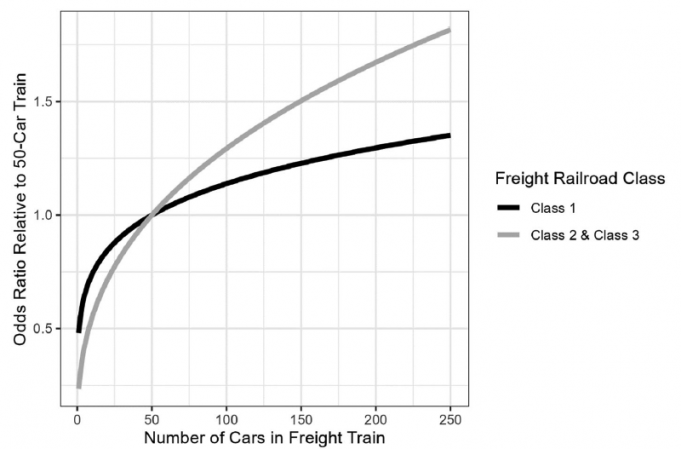Happening Now
Data Confirm Long Trains Pose Higher Risks
May 31, 2024
By Jim Mathews / President & CEO
Apart from the on-time performance problems posed by co-existence with passenger trains, as of this week we know with mathematical confidence that extra-long freight trains also pose a higher risk of derailment – and that the risk continues to grow as the length of the train grows.
Moreover, the risks are even worse for trains operated by short lines than for those operated by the big Class I railroads, roughly 1.2 times higher for Class II and III railroads, a new study out this week shows.
“Even when accounting for the reduction in the number of freight trains operated when the average train is longer, longer freight trains are associated with an increase in the aggregate odds of freight train derailment,” the study’s authors concluded. “The results presented suggest a clear, monotonic, and positive relationship between freight train length and derailment risk.”
The study’s authors – Peter Madsen of Brigham Young University, Robin Dillon of Georgetown, Konstantinos Triantis of Virginia Tech, and Joseph Bradley, also of Brigham Young University – looked at publicly available data from the Federal Railroad Administration reporting rail equipment accident data for a ten-year period between 2013 and 2022.
It’s important to note here that they corrected for the fact that running longer trains inherently reduces risk, simply by running fewer trains overall and therefore creating fewer opportunities for a derailment. Nonetheless, after taking that into account, they concluded that a 100-car train has an 11-percent higher risk of derailment than a 50-car train, and the risk for a 200-car train is 24 percent higher.
“Thus, longer trains are associated with increased derailment risk even with the reduction in exposure accounted for,” the authors said. “This increase in derailment risk is statistically significant.”

[Image above from Madsen, et al]
The Association of American Railroads, or AAR, has been saying since the East Palestine derailment that the proposed Rail Safety Act of 2023 (HR 1674 in the House, S 576 in the Senate), which would limit train length to 7,500 feet (or, roughly, 121 cars), was introduced prematurely. Instead, AAR says we should all “wait for the data” before issuing policy prescriptions.
AAR was waiting for a long-trains study from the National Academies of Science, which is being conducted because Congress directed it in the Bipartisan Infrastructure Law/Investment in Infrastructure and Jobs Act (IIJA) which passed in 2021. That study isn’t yet finished but is close.
This new study – “The Relationship Between Freight Train Length and The Risk of Derailment,” published in the journal Risk Analysis – is not part of that congressional direction, but it nonetheless offers a vital guidepost for policymakers as we all evaluate the benefits and risks of longer trains.
Ten years of data show a statistically significant correlation between train length and the risk of a derailment. While it’s certainly true that longer trains mean lower emissions for any given weight of cargo transported and lower overall costs (the authors themselves say as much in their paper), those benefits need to be measured alongside the potential for significant harm to communities as well as, selfishly, potential disruptions to passenger traffic. The recent situation for Amtrak passengers in Albuquerque is a perfect illustration of the way derailments can have widespread consequences.
AAR may well want to wait for the National Academies’ review, and will likely point to the statistically demonstrated benefits of freight trains over, for example, using trucks for cargo, as reasons to discount these kinds of findings. But if the National Academies’ work uncovers similar results – an 11 percent increase in risk for a 100-car train and a 24 percent risk increase for a 200-car train – it will be one more reason for everyone who cares about passenger rail expansion to work for sensible limits on the extra-long freight trains we’ve seen spread through the industry under the umbrella of Precision Scheduled Railroading.
“As demonstrated by the differences in risk between trains operated by larger, Class 1 railroads compared to small railroads, more stringent standards and better maintenance can help address the risk of longer trains,” the authors wrote. “This research could encourage the FRA to collect additional data on length of trains not involved in accidents so that the exposure risk can be further studied.”
We agree. This work is a statistically compelling reason to, at the very least, take a pause and a second look at what’s happening on the rail we share with freight trains across the country.
"The Rail Passenger Association's recognition of the essential work done by SMART-TD members aboard Amtrak during this difficult period is appreciated. The Golden Spike Award serves as a testament to the compassion and dedication our conductors, assistant conductors and other workers exhibit constantly through times both ordinary and extraordinary."
Jeremy Ferguson, SMART-TD President
December 21, 2021, on the Association awarding its 2021 Golden Spike Award to the Frontline Amtrak Employees.
Comments